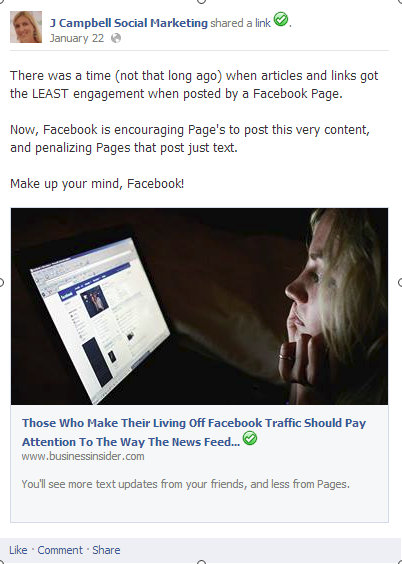There have been more changes at Facebook that have serious implications for your nonprofit’s Facebook strategy.
As a busy nonprofit professional, you may be getting discouraged. If you are like many Facebook Admins, your Page has seen a serious decrease in organic reach (people seeing your Page posts) since December, and you may be wondering why.
I know that it’s hard to keep up, so I have detailed the most recent changes in this post, along with some ways that your nonprofit can use the tweaks and changes to your advantage.
Don’t get discouraged – read on!
1) Post more articles.
In December, Facebook announced that “link share posts” – posts that include a link to an external article and pull in a thumbnail and description – get more “engagement” than links that do not pull in a thumbnail and description.
In other words, a link post formatted properly (photo 1) will get you more likes, comments and shares than one with just a link and nothing else (photo 2).
For a compulsive link-sharer like me this is a welcome change, considering that for years it was always common knowledge that links received the least amount of engagement of all content types on Facebook.
However, I am a bit confused by Facebook’s promotion of posting links to external sites – don’t they want users to stay on their site? I have a feeling this might be due to reports that Pinterest and Twitter are dramatically increasing website traffic for news organizations and Facebook wants to stay the leader of website traffic referrals.
2) Post fewer text updates.
Along with the link share posts announcement, Facebook revealed that Page Admins can expect a decrease in reach for text updates. Text updates are just what they sound like – posts that do not include a photo or a link thumbnail/preview.
As an experiment, you may want to consider eliminating text updates and decreasing photo posts, while increasing high-quality links. See if this increases engagement on your Page.
On the other hand, if you are having huge success with text and photo updates, then by all means keep doing what’s working!
3) Stop using memes.
EdgeRank checker has a great post on how Facebook may identify memes. It appears that right now Facebook does not penalize memes that are uploaded directly into Facebook Photos, as opposed to shared from an outside site like livememe.
Memes can be a cute and easy way to get quick engagement from fans, but reliance on them is dangerous and unproductive.
4) Use hashtags. (Yes, really.)
This month Facebook rolled out a new feature called Trending (see photo below). This could give large organizations more exposure if used correctly but will unlikely benefit small nonprofits.
To capitalize on this trend, I suggest keeping an eye out for what is trending on other social media sites, such as Trendsmap or Google Trends, and incorporating these topics and hashtags into your Facebook Page posts.
Facebook expert Mari Smith showed the new trending hashtag feature used in her News Feed. This could be a good opportunity for your nonprofit to jump on a relevant trend that is of interest to your online community, as well as gain exposure to new potential fans!
5) Focus on those who really love you.
Remember, Facebook has already admitted that organic (unpaid) reach for posts is down across the Board and is going to continue its downward spiral.
This is due partially to tweaks to the News Feed, but it is also due to the explosion in Facebook users and the sheer number of brands competing on Facebook for fans and for attention. News Feeds are saturated by updates from family members, friends and colleagues, as well as posts from Pages and advertisements.
There is a kind-of positive side to all of this – the Facebook fans that now see your Page posts are the most likely to share them, comment on them and like them. It is not “reach” that counts – reach is just a number. It is the engagement that you receive on the posts, and the subsequent action that you get your fans to take on your behalf.
In conclusion – Do not put your social media eggs into just one basket!
Facebook changes can be frustrating and confusing, but as we have all learned, you can’t fight the power in this case – it’s better to just roll with it and use the changes to your advantage.
How are you dealing with the new Facebook changes? Have they impacted your nonprofit’s Facebook strategy? Why or why not? Let me know in the comments.




Comments 34
RT @JuliaCSocial: 5 Ways Nonprofits Can Use the Newest Facebook Changes to Their Advantage #sm4np #nptech http://t.co/OxgD1Il9JQ
RT @Crowdvance: RT @JuliaCSocial: 5 Ways Nonprofits Can Use the Newest Facebook Changes to Their Advantage #sm4np #nptech http://t.co/OxgD1…
5 Ways Nonprofits Can Use the New Facebook Changes to Their Advantage – http://t.co/OLGziKe6yG
RT @JuliaCSocial: 5 Ways Nonprofits Can Use the Newest Facebook Changes to Their Advantage #sm4np #nptech http://t.co/7F9Ho3Xxma
5 Ways Nonprofits Can Use the New Facebook Changes to Their Advantage http://t.co/3X19KYRJQL
Julia is keeping up…..good advice!
Author
Thanks Joanne!
5 Ways Nonprofits Can Use the New Facebook Changes to Their Advantage http://t.co/XxeEbrVvWJ via @JuliaCSocial
RT @jenniferwindrum: 5 Ways Nonprofits Can Use the New Facebook Changes to Their Advantage http://t.co/XxeEbrVvWJ via @JuliaCSocial
J Campbell Social Marketing 5 Ways Nonprofits Can Use the New Facebook Changes to Their Advantage http://t.co/F46u9hCIgW
5 Ways Nonprofits Can Use the New Facebook Changes to Their Advantage http://t.co/VPKz5CSqNX via @JuliaCSocial
5 Ways Nonprofits Can Use the New Facebook Changes to Their Advantage http://t.co/p0sW5LQTGC via @JuliaCSocial
RT @501central: J Campbell Social Marketing 5 Ways Nonprofits Can Use the New Facebook Changes to Their Advantage http://t.co/vnmSQXmmwO
5 Ways Nonprofits Can Use the New Facebook Changes to Their Advantage via @JuliaCSocial http://t.co/Tzc5xnw9V7
5 Ways Nonprofits Can Use the New Facebook Changes to Their Advantage http://t.co/kEse94cEYc via @JuliaCSocial
5 Ways Nonprofits Can Use the New Facebook Changes to Their Advantage http://t.co/rxCUMXtQPH via @JuliaCSocial
5 Ways Nonprofits Can Use the New Facebook Changes to Their Advantage http://t.co/7Jz6PcpC07 via @JuliaCSocial
5 Ways Nonprofits Can Use the New Facebook Changes to Their Advantage http://t.co/d4Ly9fLgzz via @JuliaCSocial
5 Ways Nonprofits Can Use the New Facebook Changes to Their Advantage http://t.co/wL8PlMDXke via @JuliaCSocial
RT @NealSchaffer: 5 Ways Nonprofits Can Use the New Facebook Changes to Their Advantage http://t.co/d4Ly9fLgzz via @JuliaCSocial
5 Ways Nonprofits Can Use the New Facebook Changes to Their Advantage http://t.co/D7eOHqQtnU via @JuliaCSocial
RT @NewMediaAngels: 5 Ways Nonprofits Can Use the New Facebook Changes to Their Advantage http://t.co/ygNoBulN7y via @JuliaCSocial
5 Ways Nonprofits Can Use the New Facebook Changes to Their Advantage http://t.co/j7NStFNBVf via @JuliaCSocial
On FB consider decreasing text updates & photo posts, while increasing links for more traffic: http://t.co/y4bJdgM5Fm via @JuliaCSocial
RT @GuideStarUSA: On FB consider decreasing text updates & photo posts, while increasing links for more traffic: http://t.co/y4bJdgM5Fm via…
RT @GuideStarUSA: On FB consider decreasing text updates & photo posts, while increasing links for more traffic: http://t.co/y4bJdgM5Fm via…
“@douglasi: 5 Ways Nonprofits Can Use the New Facebook Changes to Their Advantage http://t.co/xk5lJQT5tg via @JuliaCSocial” @PryncessBB
“@douglasi: 5 Ways Nonprofits Can Use the New Facebook Changes to Their Advantage http://t.co/0WueSLuq0l via @JuliaCSocial” Great tips!
5 Ways Nonprofits Can Use the New Facebook Changes to Their Advantage http://t.co/fXku4qoF0N via @JuliaCSocial
5 Ways Nonprofits Can Use the New Facebook Changes to Their Advantage http://t.co/BmlnJoveZ7 via @JuliaCSocial
5 Ways Nonprofits Can Use the New Facebook Changes to Their Advantage http://t.co/GSOldSiEFH via @JuliaCSocial @NealSchaffer
5 Ways Nonprofits Can Use the New Facebook Changes to Their Advantage http://t.co/tBGujubXbB via @JuliaCSocial
RT @ProfessorGary: 5 Ways Nonprofits Can Use the New Facebook Changes to Their Advantage http://t.co/GSOldSiEFH via @JuliaCSocial @NealScha…
RT @ProfessorGary: 5 Ways Nonprofits Can Use the New Facebook Changes to Their Advantage http://t.co/GSOldSiEFH via @JuliaCSocial @NealScha…
5 Ways Nonprofits Can Use the New Facebook Changes to Their Advantage http://t.co/WnHW8vhxdk via @JuliaCSocial